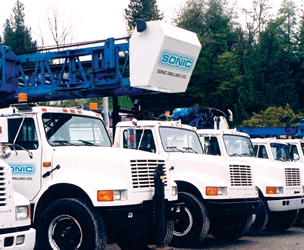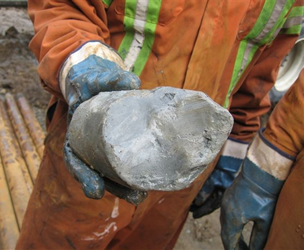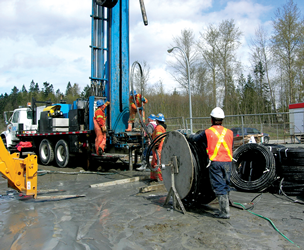geothermal melts the way for safer streets
Although it sounds revolutionary, pavement snow-melting technology has been in use in a number of countries including Argentina, Japan, Switzerland and the United States and, in some cases, for as long as 50 years.
In a typical installation, snow-melting geothermal grids are buried under sidewalks, roadways and bridges – places where a particular stretch of pavement has a specific concern due to its location, climate or local conditions. By installing a geothermal grid, the problem area gains the many advantages of snow-melting technology which include;
-
elimination of cost and inconvenience of snow and ice removal reduced wintertime liability from slick sidewalks or road surfaces a reduction in tracked-in sand, salt and slush to buildings
-
elimination of damage to sidewalks and pavement from freeze-thaw cycles.
The oldest geothermal pavement snow-melting system was installed in Klamath Falls, Oregon in 1948 by the Oregon Highway Department. This installation was designed to address safety issues along a 450-foot section of Esplanade Street which approached a traffic signal on an adverse 8% grade. In 1997, after almost 50 years of operation, this early system finally failed due to leaks in the grid caused by external corrosion. Today, Klamath’s Esplanade Street boasts a modern replacement geothermal grid that costs only $3,500 per year to maintain and operate.
The Klamath Falls area has had a long history of geothermal heat utilization, beginning with early native Indian use of the area’s natural hot springs. With the growth of the city, many wells were drilled to utilize this geothermal resource which now supplies more than 500 private homes and small businesses, a hotel, a high school, a medical centre and a college campus.
Another snow-melting installation, in the Copahue-Caviahue area of Argentina, on the slopes of the Andes, uses geothermal energy for heating streets and an access road to a local ski resort. Considering that winter temperatures in the area often drop to as low as 10 F (-12 C) with winds reaching speeds of 100 mph (160 kmh) and snow accumulating to depths of 13 feet (4 m), this area’s geothermal resource is a welcome defender against the cold.
Using heat from the Copahue-Caviahue thermal area, the pavement temperature can be kept between 54-61 F (12-16 C). By using radiant panels underneath the road surface, nearly 24,000 sq. ft of road surface can be heated. Similarly, in the Akita prefecture in north-west Japan, motorists were often at the mercy of the area’s high Shirakami mountain range, formed long ago by volcanic activity. At the entrance to a main tunnel, unsuspecting motorists travelling up from the sunny valley below were surprised to suddenly find themselves driving on ice. In September 2004, the government of Akita prefecture decided it would put geothermal energy to use by embarking on a roadway snow-melting project to keep the tunnel entrance bare and dry.
Due to the area’s tough rock formation, a Tone-Sonic drill rig was used to drill the geothermal holes for this project. Licenced by the Sonic Drill Corporation to service the Asian marketplace, Toa-Tone Boring Co., Ltd. manufactures the same patented drill head as those manufactured by its developer, Sonic Drill Corporation. For the Akita project, 28 holes were drilled through volcanic andicite rock using 7” casings (178 mm) to a depth of 300 ft. (100 m). Although andicite presents a challenging rock formation, it does fracture which allows the sonic drill to penetrate while also delivering superior performance results.
In this instance, the Akita geothermal grid marked the first time a sonic drill had been used in that type of application. Since that time, sonic drills have been utilized in geothermal drilling applications in countries around the world where it has distinguished itself as the fastest drill on earth. In addition to being 3-5 times faster than other rigs, it also cores, cases and grouts in one easy operation, without the use of drilling mud.
Developed by Ray Roussy, a professional engineer and president of the Sonic Drill Corporation, the sonic drill head is unique in its ability to fluidize surrounding soil particles.
At first glance, a sonic drill rig looks very much like a conventional air or mud rotary drill rig, with the exception of a slightly larger-than-standard head, but it is inside this head that Roussy’s patented technology can be found. Despite attempts by other companies to copy Roussy’s innovations, the sonic drill head, manufactured by the Sonic Drill Corporation, is the only head to contain this patented technology.
The “Roussy head” is able to produce such incredible drilling speed, even in overburden conditions, thanks to a mechanism for rotary motion, as well as an oscillator, which causes a high frequency force to be superimposed on the drill string. The drill bit physically vibrates up and down, in addition to being pushed down and rotated. These three forces combine to allow rapid drilling through most geological formations. In particular, it is able to “buzz” easily through mixed soils, giving it a significant advantage – one that is perfectly suited for geothermal use where, typically, the speed of installation will ultimately determine the profit margin.


